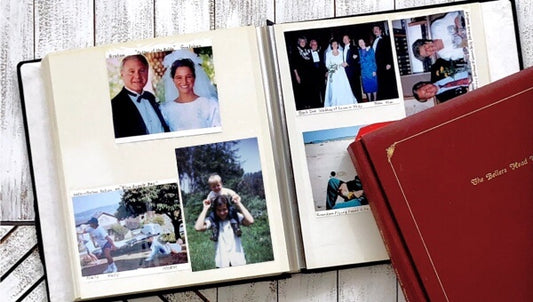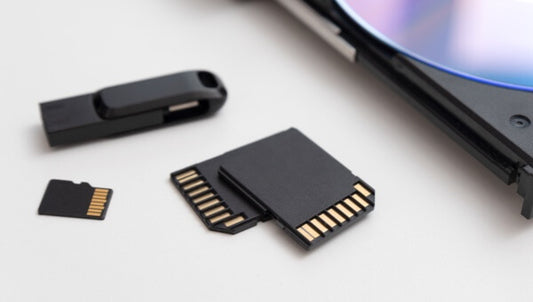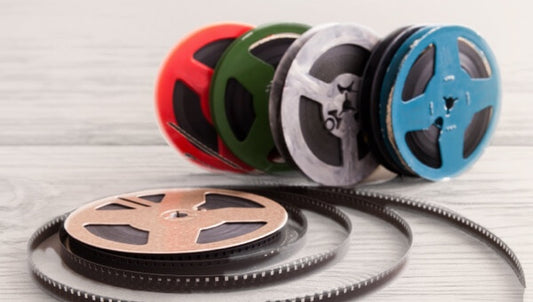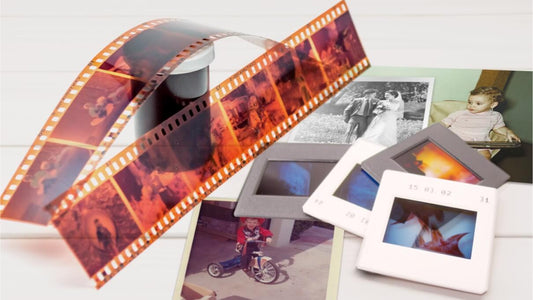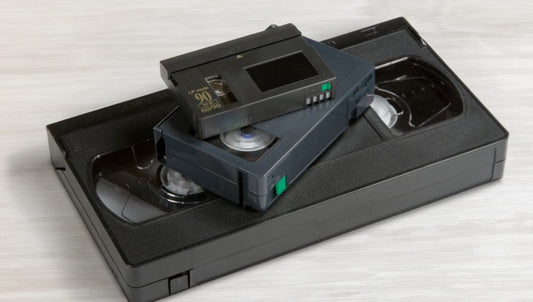For years, VHS tapes were the most popular choice for capturing home movies as well as watching Hollywood and Disney classics, getting video rentals, and documenting history. But when was VHS invented and how did it become an integral part of what was popular in the 80s, 90s, and into the 2000s? Keep reading to learn about VHS origins and inventions, the format war and battle between Betamax and VHS, the main innovators and milestones of VHS technology, and the decline of the format we all loved.
Jump To:
What Is VHS?
VHS, short for Video Home System, is an analog videocassette format designed for recording and playing video and audio. Developed by JVC, it uses magnetic tape housed inside a plastic cassette to store home movies and television programs for playback on a VCR.

VHS tapes invention changed how families recorded, watched, and shared movies at home.
What Came Before VHS?
Before we tell you all about VHS and its invention, it helps to look at what came before it. Long after the first video was recorded, most families still relied on film-based formats like Super 8 and other reel-to-reel systems to capture their memories. These formats were expensive, difficult to handle, and required projectors for playback. Hollywood had already been using magnetic tape since the 1950s, but it wasn’t practical or affordable for home use.
By the early 1970s, new technologies began to bridge that gap. Some of the key formats that came before VHS included:
- Super 8 film – a popular option for home movies but costly and time-consuming to process
- Reel-to-reel video systems – bulky equipment mainly used by professionals
- U-Matic tapes – introduced by JVC in 1971, marking one of the first steps toward home video recording
These innovations set the stage for the creation of a truly consumer-friendly video format that would soon redefine how people recorded and watched their favorite moments at home.
When Was VHS Invented and Who Invented It?
The official invention date of VHS is September 9, 1976, when JVC introduced the Video Home System in Japan. It was later released to the public in the United States on August 23, 1977. While both years are often mentioned, 1976 is the most accurate answer to “When was VHS invented?” since that’s when the first functional system became available.
The name VHS stands for Video Home System, though it originally referred to Vertical Helical Scan, the magnetic tape-recording process developed by JVC engineers.
The history of VHS began in 1969, when JVC collaborated with Sony and Matsushita Electric (later known as Panasonic) to create a video recording standard for Japanese consumers. This partnership resulted in the U-Matic, the first cassette-based video format. After the collaboration ended, each company went its own way; Sony developed Betamax, Matsushita pursued its own version, and JVC continued refining what would become VHS.

Before VHS, home videos were recorded on Super 8 and reel-to-reel film.
Led by Yuma Shiraishi and Shizuo Takano, JVC’s engineering team set out to design a video recorder that was affordable, compatible with regular televisions, and capable of recording at least two hours of footage. By 1973, they had built a working prototype, and by 1975, the company released the CR-6060, the first VHS recorder.
When JVC officially launched the VHS format in 1976, it offered consumers something revolutionary - long recording times, easy playback, and wide compatibility. Its open standard allowed other manufacturers like Sharp and Philips to produce compatible devices, making VHS more affordable and accessible than competitors and paving the way for its dominance in the home video market.
Fun fact: VHS was designed to record two hours of content; just enough for a feature-length movie.
Invention Milestones: The Evolution of VHS
The invention of the VHS is only part of the history of VHS. The truth is that VHS machines revolutionized home recording. When the first VCR came out, it finally made it affordable and easy to watch movies at home while also being able to rewind, pause, and fast-forward.
The first VHS VCR, or Video Cassette Recorder, was the Victor HR-3300 which was released in 1976, but the first in the United States was the RCA VBT200. Additionally, the first video camera was invented for VHS tapes in the early 80s along with the new VHS-C or compact VHS movies.
Because of their smaller size, VHS-C tapes made recording home videos easier and more convenient. Families could now watch, record, and rewatch personal memories like birthdays, weddings, and holidays with ease.
Other types of VHS tapes were also released including:
- Super VHS (S-VHS) – provided higher picture quality and better resolution for home recordings
- Super Compact VHS (S-VHS-C) – a smaller, upgraded version offering portability and improved performance
These advancements and the fact that VHS players and tapes were more affordable and available than competing formats meant that the old video camera, home recording, and movie-watching format dominated the market share for the next 15 years or so.
📼 VHS Timeline: Key Dates in History
- 1950s – Magnetic tape recording used in television production for the first time.
- 1971 – JVC releases the U-Matic tape, an early step toward home video.
- September 9, 1976 – VHS officially introduced in Japan by JVC.
- August 23, 1977 – VHS released to the public in the United States.
- 1976–1977 – The format war between VHS and Betamax begins.
- 1983 – VHS players drop in price to around $400–$1,000, making them more accessible.
- 1985 – Average VCR price falls below $400 as rentals surge in popularity.
- 1996–1997 – DVDs launch in Japan and the U.S., signaling the beginning of VHS decline.
- 2006 – Final Hollywood movie released on VHS: A History of Violence.
- 2016 – Funai Electric produces the last VCR, ending 40 years of VHS history.
A Cultural Phenomenon: VHS Takes the World by Storm
If you grew up watching Disney classics, 1980s horror movies, or early action films, there’s a good chance you saw them on VHS tapes. During the 1980s and 1990s, VHS became the most popular home entertainment format in the world, used for both Hollywood movies and personal home videos.
It also led to the rise of rental stores like Blockbuster. While these rental stores are now a relic of the past, for over a decade they were a cornerstone in culture, and going to pick out a couple of movies on a Friday night became a popular activity across the world.
People began to amass huge collections of VHS cassette tapes, and any major movie release would come out on VHS. However, the digital age was coming with the first digital cameras coming in the early and mid-1990s. Pretty soon, people began to convert from VHS to digital format as new formats were being introduced.

The first VHS players and cameras made home recording easy and popular.
Legacy and Obsolescence: The Decline of VHS
When DVD came out in Japan in 1996 and the United States in 1997, it was clear that the end of VHS was in sight. Although the last VHS movie wouldn’t be released until several years later, DVD and later Blu-ray formats quickly began taking over the home video market before the new millennium. The VHS format was slowly phased out as the digital age took hold.
DVDs offered clear advantages over VHS tapes, including better picture and sound quality, compact size, chapter navigation, interactive menus, and larger storage capacity. While many people continued using VHS players for a few years, the transition to digital media was inevitable.
The final major Hollywood film released on VHS was A History of Violence in 2006, marking the official end of commercial VHS production. By 2016, the last company still producing VCRs, Funai Electric, also ended production, closing the chapter on VHS hardware for good.
Still, VHS holds a lasting place in cultural memory. People continue to associate the format with nostalgia and family traditions, from recording home videos to watching favorite films on repeat. However, because magnetic tapes degrade over time, it’s important to digitize home movies to preserve those memories for the future.
Frequently Asked Questions
How much did a VCR cost in 1985?
In 1985, a typical VCR cost between $200 and $400, depending on the brand and features. Earlier models were much more expensive, but by the mid-1980s, prices had dropped enough to make VCRs a common household item.
What was the first movie to be put on VHS?
The first movie ever released on VHS was “The Young Teacher” in 1976. Produced by South Korea’s Kaifa Video, it marked the beginning of commercial home video distribution before VHS expanded worldwide.
When was VHS available to the public?
VHS became available to the public on August 23, 1977, when JVC officially released the format in the United States following its debut in Japan the previous year.
How much was a VHS player in 1983?
In 1983, a new VHS player typically cost between $400 and $1,000, depending on the brand and features. Prices began to drop later in the decade as the technology became more common in households.
What was the last VHS player ever made?
The last VHS player ever made was produced by Funai Electric in July 2016. It marked the end of an era for VHS technology after nearly 40 years of production.
What is the lifespan of a VHS tape?
On average, a VHS tape lasts between 10 and 25 years, depending on storage conditions. Exposure to heat, humidity, and frequent playback can shorten its lifespan, while keeping tapes in a cool, dry place can help them last longer.
Did they use VHS in the 90s?
Yes, VHS was widely used throughout the 1990s, remaining the dominant format for home movies, rentals, and recordings. It wasn’t until the late 1990s and early 2000s that DVDs began to replace VHS as the main home video format.

Collectors and movie fans still ask about VHS history and rare tapes.
Preserving the Legacy of VHS
Now, if a friend asks, “When was VHS invented?” you can give them a detailed answer about how it was released in Japan in 1976 and how VHS inventors revolutionized home recording technology and paved the way for future digital formats. Just make sure that your nostalgia doesn’t cloud your logic and make you keep VHS tapes without digital copies because they will only last so long before losing data and wearing out.
If you have old VHS tapes lying around, Capture can convert them to high-quality digital format and upload them to your Google Photos library for an affordable price






